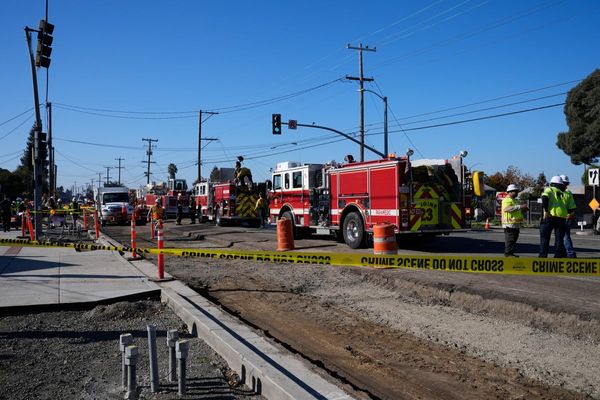The Agriculture Department said Friday it can’t use a special reserve fund to pay food stamp benefits during the partial government shutdown because the money is meant to be used when appropriations fall short, not when the funding doesn’t exist.
In a memo released amid Democratic lawmakers’ pressure to get USDA to tap the fund, the department reiterated that it would not pay November benefits for the Supplemental Nutrition Assistance Program, better known as food stamps. It also told states they wouldn’t be reimbursed if they pay the benefits.
“SNAP contingency funds are only available to supplement regular monthly benefits when amounts have been appropriated for, but are insufficient to cover, benefits. The contingency fund is not available to support FY 2026 regular benefits, because the appropriation for regular benefits no longer exists,” the memo says.
The memo also appears to contradict the department’s shutdown plan released in late September, when it referred to the contingency fund as part of its SNAP plan. The partial government shutdown began with the new fiscal year on Oct. 1. Senate Democrats have rejected a continuing resolution passed by the House that would fund the government until Nov. 21.
“Congressional intent is evident that SNAP’s operations should continue since the program has been provided with multi-year contingency funds that can be used for State Administrative Expenses to ensure that the State can also continue operations during a Federal Government shutdown,” the shutdown plan said. “These multi-year contingency funds are also available to fund participant benefits in the event that a lapse occurs in the middle of the fiscal year.”
But the Friday memo said the fund is to provide benefits in disasters such as hurricanes, tornadoes and floods “that can come on quickly and without notice. For example, Hurricane Melissa is currently swirling in the Caribbean and could reach Florida.”
SNAP provides benefits to nearly 42 million people a month.
Democrats in both chambers and outside advocates say that USDA has at least $5 billion in its contingency fund. More than 200 Democrats sent a letter Friday Agriculture Secretary Brooke Rollins urging her agency to use the contingency fund for November SNAP benefits and provide guidance to states on how to issue such benefits.
Forty-four Senate Democrats also sent a letter to Rollins Wednesday to urge her to change course. Independents Angus King of Maine and Bernie Sanders of Vermont, who caucus with Democrats, also signed the letter.
The SNAP program costs about $8 billion a month. USDA critics say it could use the contingency fund to pay at least part of the November benefits.
“Congress already provided billions of dollars to fund SNAP in November. It is the Trump administration that is taking food assistance away from 42 million Americans next month — including hungry seniors, veterans, and families with children,” House Agriculture ranking member Angie Craig, D-Minn., and Appropriations ranking member Rosa DeLauro, D-Conn., said in a statement.
DeLauro and Craig pointed to a Government Accountability Office finding after the last lengthy shutdown, in late 2018 and early 2019, that the SNAP contingency reserve had been available to make benefit payments.
Other sources
The USDA memo Friday also says transferring funds to SNAP from other sources, such as the Section 32 account established by a 1935 agriculture law, would pull money away from child nutrition programs and the Special Supplemental Nutrition Assistance Program for Women, Infants and Children.
The Section 32 account is permanently appropriated with 30 percent of customs receipts. The Congressional Research Service estimated in August that there’s approximately $25 billion in the fund for fiscal 2026.
The USDA memo Friday said that the agency transferred $23 billion from the account to pay for child nutrition programs.
“These funds are also temporarily supporting the Special Supplemental Nutrition Assistance Program for Women, Infants and Children (WIC). Additional transfers will be needed to support WIC and will be taken from the [Child Nutrition Programs] full-year appropriation,” the memo said.
Several states say they won’t be able to pay November SNAP benefits, including New York, Arkansas, Missouri, New Hampshire and California.
“There is no provision or allowance under current law for States to cover the cost of benefits and be reimbursed,” USDA said, saying that states will be unable to pay SNAP benefits.
Congressional intervention?
Congress could also be an avenue to fund food stamps during the shutdown.
Sen. Josh Hawley, R-Mo., introduced a bill that would fund SNAP during the shutdown. Hawley has said he intends to ask for unanimous consent to either pass the measure or get a vote scheduled. He said Thursday that he had no commitment from leadership to take up his bill but is working to get bipartisan support for the legislation.
Senate Majority Leader John Thune, R-S.D., has demurred when asked by reporters about scheduling a vote. Senate passage of the bill would put the issue in the hands of the House, which hasn’t been working since the shutdown began.
Hawley has picked up some momentum, however, at least on his side of the aisle.
As of Friday, six Republicans had signed on as co-sponsors, according to Hawley’s staff: Sens. James Lankford of Oklahoma; Marsha Blackburn of Tennessee; Susan Collins of Maine; Bernie Moreno of Ohio; Kevin Cramer of North Dakota; and Lisa Murkowski of Alaska.
Aris Folley contributed to this report.
The post USDA says it can’t use contingency fund for food stamps appeared first on Roll Call.







